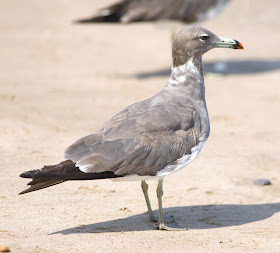 |
| Sociable Lapwing |
After a lengthy tour of five European countries (Italy, Finland, United Kingdom, Portugal and Spain: see following posts) we had a few days in Muscat, Oman, on our way home. Our hotel was close to a beach used by local fishing boats so we checked it out just as a boat was offloading a catch.
 |
| Caspian Gull |
Large numbers of gulls were present including Caspian, Common, Slender-billed, Lesser Black-backed (fuscus fuscus Baltic) and Sooty.
 |
| Slender-billed Gull |
 |
| Sooty Gull |
Offshore were a few Common Terns and large flocks of Red-necked Phalaropes.
 |
| Red-necked Phalaropes |
Crested Tern and Lesser Crested Tern (the latter scarce in Oman) were present on the beach with the gulls.
 |
| Crested Tern (middle) & Lesser Crested Terns |
The following day I had
hired a local driver, Nabeel, to pick me up at the hotel at 5.30am
for a day in the field. We drove just over an hour to reach a wadi
near Nakhal where Arabian Partridge had been reported.
 |
| Nakhal wadi & Nabeel |
We found none but the scenery was superb and a few birds were about including Indian Silverbill, Green Sandpiper and Pale Crag-Martin. Then a bird showed which puzzled me until I worked out after I got home that it had to be a Pale Rockfinch.
 |
| Green Sandpiper |
 |
| Indian Silverbill |
We then headed north-west to Sawadi Beach where I had arranged to hire a young man to take us out to the delightful Daymaniyat Islands (below) offshore.
We circled several islands, enjoying fabulously close views of Socrota Cormorant (3 on one island and 1 on a second island), a species I’d seen just once previously, and then poorly, in the neighbouring United Arab Emirates. Great Cormorants and Western Reef-Egrets were present.
 |
| Socrota Cormorant |
Around the outermost islands we found a nice flock of Persian Shearwaters (below) a lifer for me, offering similarly close views.
With them was a single Red-necked Phalarope (below).
Circling one island we had an immature Sooty Falcon (below) fly overhead.
We landed on the main island, Jazirat Jabal, and did the steep climb to an ancient lookout post at the summit. Others had reported Egyptian Nightjar roosting here but we failed to score. A few passerines present included Black Redstart (below) and Red-tailed (Persian) Wheatear.
Our next stop was
eastwards to the fields and cultivated flatlands of the Barka area.
There were several reports of Sociable Lapwing from this area last
year and records in recent years suggested this may be an important
wintering ground for this endangered shorebird, which had long been
high on my target list. We searched sites where
birds were seen most recently and were about to give up when we
decided to give one area near the Al Nahda Resort a final lookover.
This was fortuitous because I spotted two lapwings in a field that
we’d overlooked earlier. Further searching found 11 more: 13 in
all. This was a trip highlight and I’m thankful to Dr S.S. Suresh
for guidance with both this site and the Daymaniyat Islands.
Of surprise was a large flock of about 80 mixed Pin-tailed and Common Snipe (some in the image below) roosting under bushes on a dry paddock with no water in site.
Arabian Green Bee-eaters added a colourful touch to the landscape.











No comments:
Post a Comment